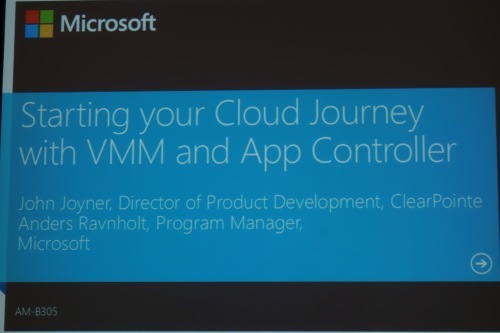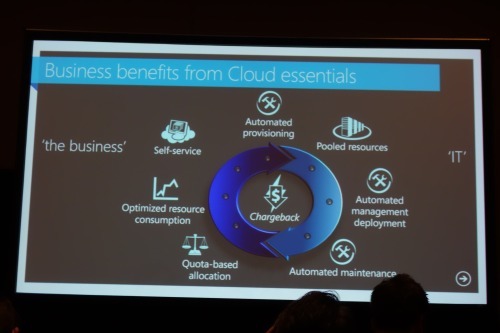Speakers:
- John Joyner, Director of Product Development for ClearPointe
- Anders Ravnholt, Program Manager for Microsoft
I’ll lead by stating that the presentation stated with some VMM background and I’ve tried to make some helpful notes I listened to the presentation, but what I really wanted to see was App Controller. By its name I fooled into thinking it was more about desktop applications, but strictly for delegating control over the self service access to data center and cloud hosted resources, assigning permissions, quota’s etc. So if you don’t care about virtual machine deployment, you probably don’t care about “App Controller”.

No cloud presentation can begin without 20 minutes of defining it and promoting the business benefits. This session was no exception, but I’m happy to report it was delivered at the right technical level. There is nothing more frustrating to attend technical session at a technical conference and be spoken down to.
App Controller handles the self-service aspect; Orchestrator automates service delivery and deployment from an IT perspective. Just remember that the “user” here is likely an admin (or potentially a developer; whoever would care to spin up virtual machines in your environment).
Especially when talking about managing cloud, you’ll hear the term “fabric” more and more; this simply refers to the hardware that makes up your data center (specifically: servers, networking, and storage)

Clouds are logical groupings of resources, which are assigned to applications based on quotas. Resource pools, by definition, must be assigned based on assigned quotas. For services for which you wish to provide 100% assignment and let the application peg out those resources when the upper limits are hit, that would be a scenario best addressed by physical server allocation.
VMM abstracts all resources including networking. A demo in the keynote showed an application being moved from one data center to another while keeping the IP address of the original application. It looked like a duplicate IP issue having two services running with the same IP, but this is just at the application level. VMM lets you keep such resources separated so conflicts are not an issue.
In VMM you assign actions to user roles. There are many provided and you can create custom roles as well. Goal is to let those permitted take action without involving administrators.
Next you assign Quota Capacity, such as how many machines, how much memory, storage, how many CPUs, etc. The benefit of quotas here is not only to provide visibility but it protects against runaway automation processes that might suck up all your resources. It of course also addresses the scenario of handling “greedy” admins that may choose to take large amounts of resources.
Service Provider Foundation which groups remote resources for use by VMM has no user interface, it is a web based service but you can control it via PowerShell. “Get-command –module spfadmin” will return a number of cmdlets you may use. To make use of SPF, you need a URI which requires a GUID for the tenant which you can obtain using the PowerShell cmdlet get-SCSPFTenant. It was suprising to me that key information was not easier to obtain; Microsoft must be using relatively simple needs like this to push admins toward PowerShell scripting.
While more than half of those in the audience had some experience with VMM, nobody raised their hands to claim hands-on experience with App Controller.
App Controller is Cloud Independent (Azure, Hosted, On-premise—it’s all the same to App Controller). Based on what has been allocated to you as a tenant, you see the resources you have available to you.
From within your available clouds, you simply click deploy and then choose a template to establish a new virtual server. The workflow is very clean and highly customizable thanks to the template feature. The things you can do with clouds that are local or in Azure may be leveraged and managed identically.
Moving local clouds in VMM to Windows Azure is another use for App Controller SP1.
All and all I think it was a good session. If there is demand I can carve out some time in the future to go into more depth. My thinking is that this is a well-covered subject and so as it was not “desktop application” focused, it is not as interesting to me as a desktop admin. But creation and use of virtual machines is certainly a common task for the desktop administrator so it isn’t too far out of a subject. So, any interest in more specifics here, please do comment so I can judge if more depth here would be a good use of my time.

Comments